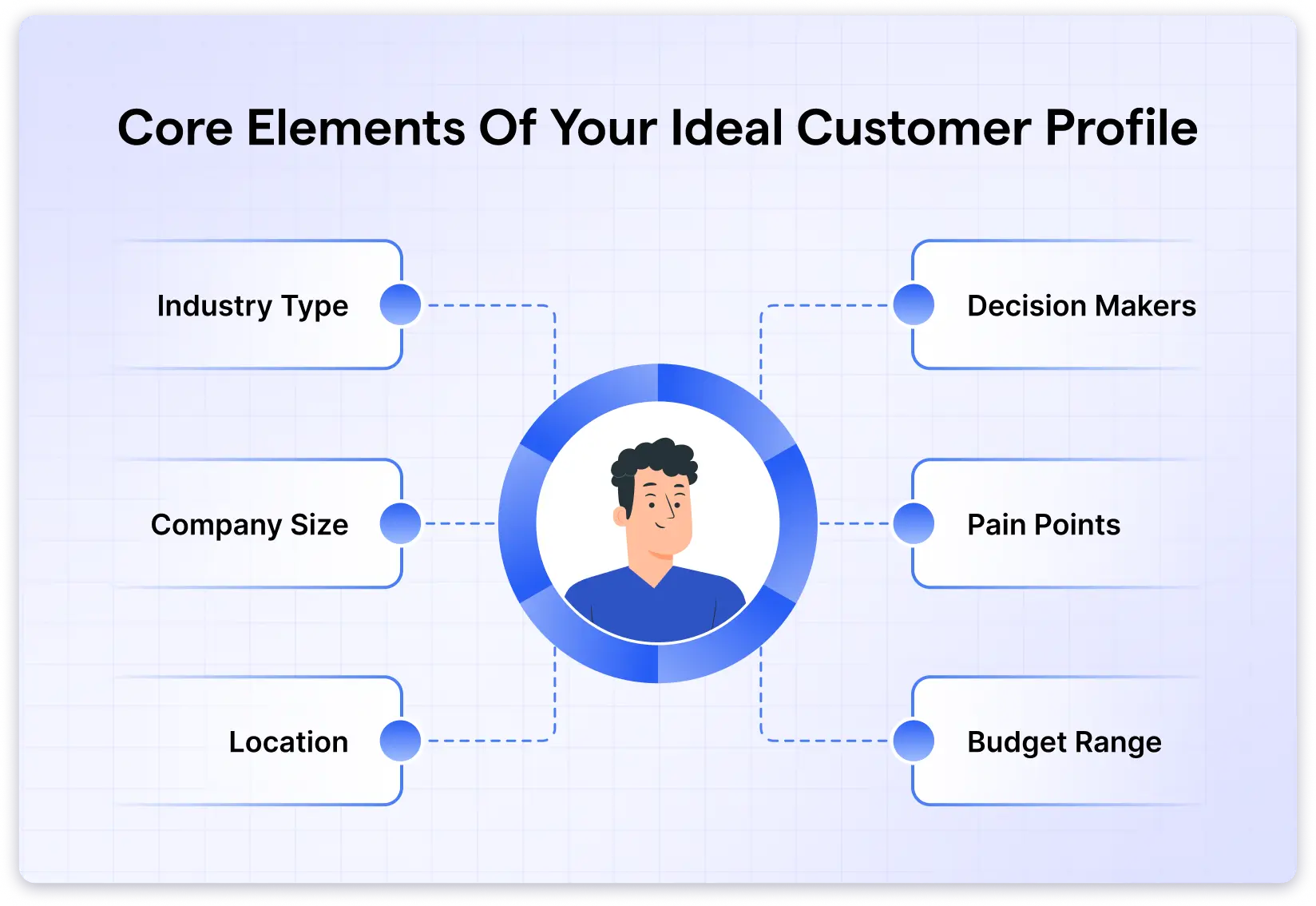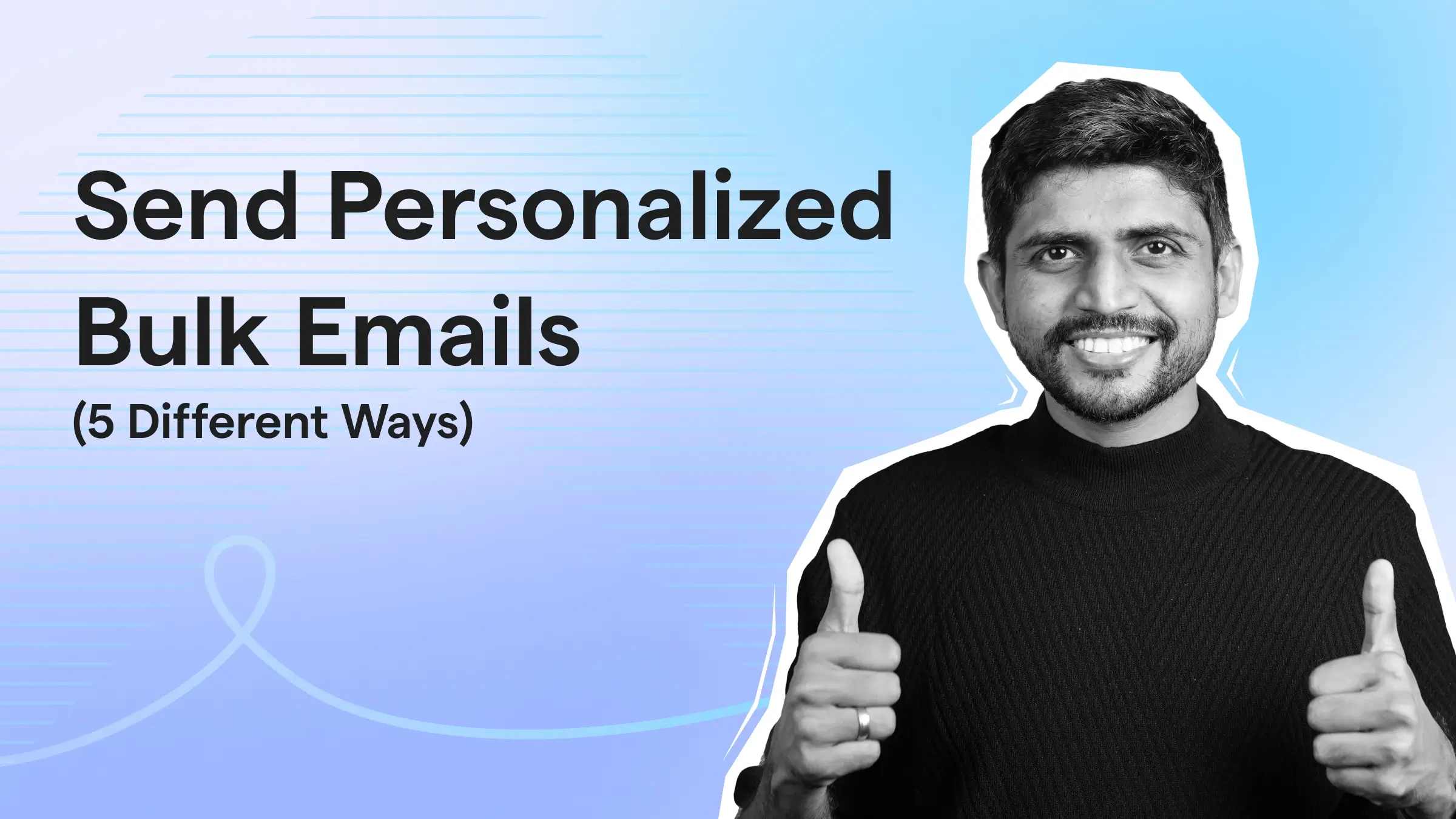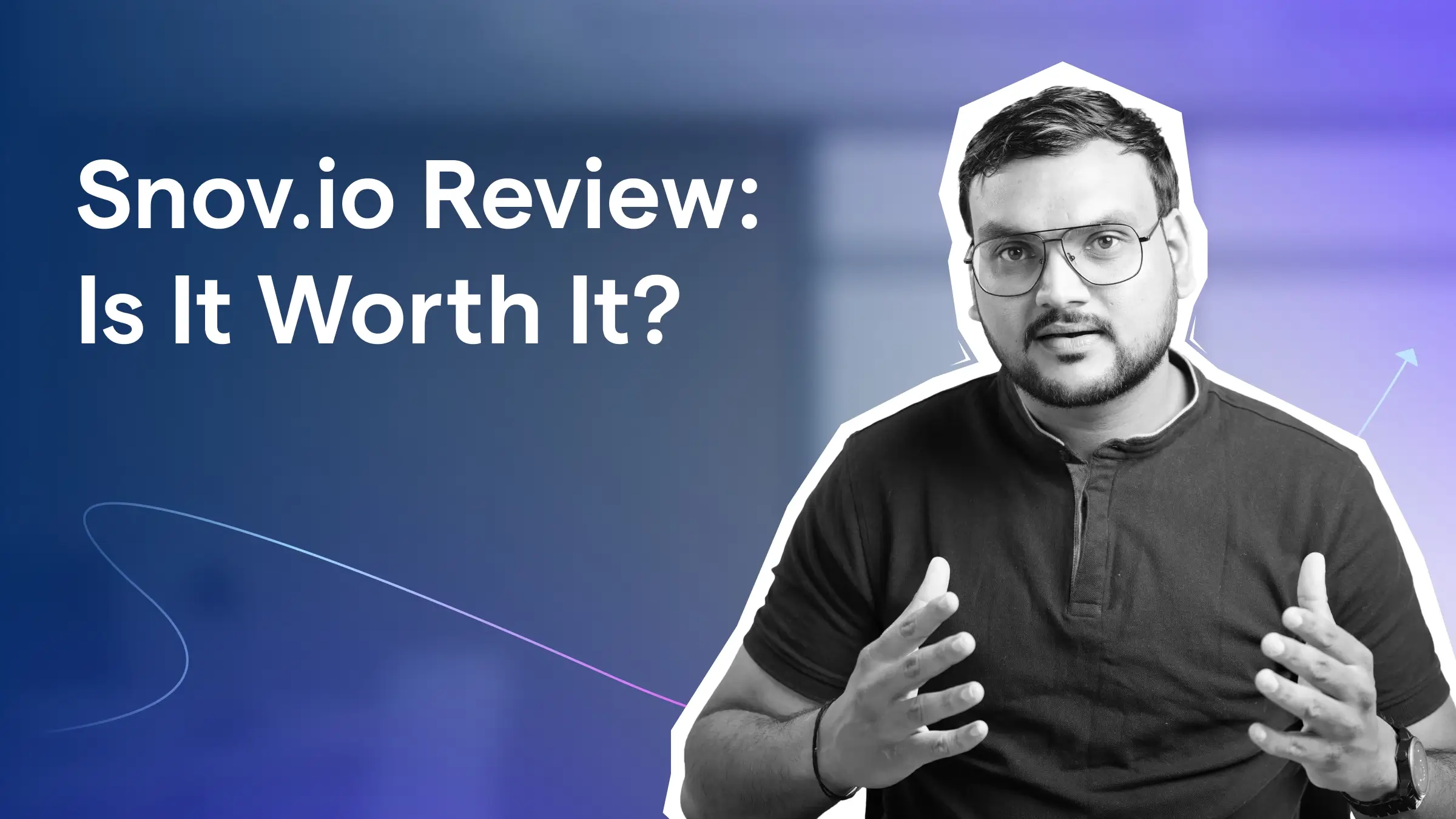Contents
- 1 Cold Email List: TOC
- 2 6-Step Process for Building a High-Quality Cold Email List
- 2.1 1. Define Your ICP & Buyer Personas
- 2.2 2. Build Your Cold Email List from the Right Channels
- 2.3 3. Verify Email Addresses
- 2.4 4. Segment Your Leads for Personalized and Relevant Outreach
- 2.5 5. Regularly Update and Maintain Your Lead List
- 2.6 6. Follow Compliance and Best Practices for Ethical Cold Emailing
- 3 Time to Get Your Emails and Domain Ready for Cold Emailing
- 4 Cold Email List: FAQs
- 4.1 1. What is the difference between buying leads and building email lead lists?
- 4.2 2. Is lead enrichment necessary for building a high-quality lead list?
- 4.3 3. What is the importance of lead scoring in identifying quality leads?
- 4.4 4. What is the importance of following legal guidelines while building a cold email list?
- 4.5 5. How do I re-engage my cold email list?
How does it feel driving the best car with a flat tire?
Well, that is exactly how you feel scaling your outreach with a bad lead list.
It slows you down while damaging everything that helps you move.
All the time and resources poured into your cold emails
can result in low open rates and high bounce rates.
I have been there too, and I know how discouraging it feels.
But this can be easily avoided by building a high-quality lead list the right way.
In this blog, I will show you my entire process for
building a cold email list that drives high engagement.
Let us get to work.
Cold Email List: TOC
6-Step Process for Building a High-Quality Cold Email List
Now, let us look at the step-by-step process to build a high-quality cold email list:
- Define Your ICP & Buyer Personas
- Research Potential Leads from the Right Channels
- Verify Email Addresses
- Segment Your Leads for Personalized and Relevant Outreach
- Regularly Update and Maintain Your Lead List
- Follow Compliance and Best Practices for Ethical Cold Emailing
1. Define Your ICP & Buyer Personas
The first step in creating your cold email list is understanding and setting up your Ideal Customer Profile & buyer personas.
But what exactly are they?
ICP defines the companies you should target, the ones that will most likely benefit from your product or service.

It also includes factors like goals, the tools they use, and their other resources.
Buyer personas, on the other hand, are a profile of the people inside those companies (business decision makers).
It includes factors like motivations, communication preferences, and role-specific needs.
This will help with lead generation and personalization when sending cold emails.
To make it happen, start by looking at your existing customers.
Interacting with your customers gives you the best feedback, and it helps a lot in refining your offering.
You can also look at your competitors and learn about their top customers.
It is a great option for those just starting out and without a large customer base.
So yeah, this is how I created my ICP and buyer personas.
2. Build Your Cold Email List from the Right Channels
Once you know your ICPs and buyer personas, it will be far easier for lead generation.
The only question is, how will you find them?
When it comes to lead generation strategies, my go-to approach is multi-channel.
This includes:
- LinkedIn Outreach & Platform-Based Prospecting
- Competitor Research to Find Potential Leads
- Use Reliable Lead Finder Tools or Data Providers
- Source From Lead-Generation Agencies
- Install Chrome Extensions to Extract Email Information
- Use Content Marketing to Generate Inbound Leads
- Get High-Intent Leads With Website Visitor Tracking
- Run Targeted Paid Advertising Campaigns to Generate Inbound Leads
- Take Part in Networking Events & Webinars
1. LinkedIn Outreach & Platform-Based Prospecting
Before we look for the steps, I highly recommend being active on LinkedIn and engaging with your ICPs.
This helps you build genuine connections before you even start your outreach.
Now, when it comes to finding leads in LinkedIn, you can take two approaches:
In order to find leads using LinkedIn, there are mainly two ways:
1. Using LinkedIn’s Search Filters:
- Open LinkedIn, and choose search.
- Type in keywords related to your ICP.
- LinkedIn will then give you results based on it.
From here, you can customize the filters to find leads for your cold email list.
You can also use LinkedIn’s advanced search filters to further narrow down leads.
2. Using LinkedIn Sales Navigator
- Open Sales Navigator and click on the Leads tab.
- Apply filters to narrow down your ICP.
Now, wait for Sales Navigator to show relevant leads.
Pro tip: Enable real-time alerts to get notified when new leads match your filters. You can save up to 50 searches and 50 leads, which can be modified anytime.
2. Competitor Research to Find Potential Leads
I had mentioned doing competitor research to understand your ICPs and buyer personas.
You can also use it to find potential leads who are currently working with or struggling with your competitors.
While finding a complete client list may not be possible, you get useful information from the following:
- Competitor websites (look for case studies or “Our Clients” sections)
- Review platforms like G2 or Capterra
- Industry forums or communities
- LinkedIn posts mentioning collaborations or partnerships
- News or press releases that highlight client relationships
You can then use these insights to build a targeted segment for your cold email list.
Pro tip: You can use tools like SimilarWeb or BuiltWith to analyze which companies are using your competitors’ tech stack or platforms.
3. Use Reliable Lead Finder Tools or Data Providers
Manually finding leads is a time-consuming process that drains both time and resources.
That is why I always recommend using a lead finder tool or buying data from a trusted source.
While there are many lead generation tools in the market, I use Saleshandy Lead Finder.
It offers an impressive 700M+ B2B contacts from 60M+ companies with an accuracy of 98%!
You just need to type in your requirement to the AI Lead Finder, and it will show high-quality leads that match your needs.

There are also advanced filters to find leads from even the most niche categories.
Plus, I can reveal up to 10,000 contacts in bulk at once.
This is a huge time-saver for large-scale campaigns.
It also offers easy integration with popular CRMs like HubSpot, Salesforce, Zoho, and other tech stacks.
And, to run cold outreach campaigns, you can easily import your leads to Saleshandy’s cold email platform.
That means I can build my cold email lead list, verify emails, warm up new domains, and run complete outreach campaigns, all in one place.
The cold email platform also has some useful features like:
Email verification, warming features, and Inbox Radar by Saleshandy (Inbox placement tester).
Overall, it is a great tool for anyone building or scaling their outreach efforts.
You can read our detailed review of Saleshandy to make a better decision.
4. Source From Lead-Generation Agencies
Along with using tools, you can also let agencies take the lead on lead generation.
They have expertise in extracting leads from niche categories and have many verified sources.
However, finding the right agency that truly meets your needs can be tricky.
You can consider checking Saleshandy’s Agency Portal.
It is a curated platform where you can discover and connect with a variety of verified lead-generation agencies.
This makes it much easier to outsource parts of your list-building process, without stretching your resources while building your cold email list.
5. Install Chrome Extensions to Extract Email Information
While searching for your ICPs, an extension can ease the process of setting up your cold email list.
Let us take Saleshandy Connect as an example.

With this, I just need to:
- Load the prospect’s LinkedIn profile.
- Open the extension.
- Choose View Email to get their email address.
You can now import this data directly into Saleshandy and use it for your outreach campaigns.
Apart from Saleshandy Connect, there are several other LinkedIn Chrome extensions you can check.
6. Use Content Marketing to Generate Inbound Leads
On average, a human spends over six hours per day consuming content.
This includes reading, streaming, and scrolling through social media.
And that is also one of the best places to find leads for your cold email list.
So start creating content that offers them value.
This can include sharing information that will be useful for them as well as offering solutions to your ICPs’ common pain points.
Your content can include blog, social media posts (LinkedIn, X, Facebook, etc), videos, and even audio podcasts.
All of this offers immense potential to attract leads by creating content that provides value.
Along with good content, if you also focus on proper SEO,

Your content will rank on top, which results in increased brand awareness to increases audience trust.
Thus, all of this results in a better flow of inbound leads.
Speaking of ranking higher, here is a cheat code: target niche-specific topics.
Creating content around niche-specific keywords can help you rank well, as usually these categories have almost no competition.
You can also use content marketing to grow your personal brand.
Because of recent trends, people tend to trust brands associated with individuals.
However, content marketing is a long-term strategy, and you will need to stay consistent while investing resources in it.
For a small team, it is resource-intensive and might not be a viable option.
7. Get High-Intent Leads With Website Visitor Tracking
You can also keep track of the visitors to your website, and collect their contact information with the way of offering a helpful bot, announcing offers, or even newsletters.
With this, you will be able to generate leads with high intent for your cold email list.
There are also plenty of tools that offer you data about visitors to your website, but never share much information about them.
However, these apps still provide information to run targeted ads to capture their attention.
8. Run Targeted Paid Advertising Campaigns to Generate Inbound Leads
If you want faster results, then ad campaigns should be in your lead generation strategies for your cold emailing list.
With paid ads, you can:
- Easily reach target customers
- Improve your offerings and brand awareness
- Bring in inbound leads.
There are many popular platforms like Google Ads, Meta Ads, and others, which make it easy to set up and run your ad campaigns.
However, you need to have clear targeting and budget control.
Else, your ad campaigns can quickly drain resources with almost no returns.
You also always need to experiment with the headlines, visuals, and ad copy based on performance metrics like click-through rates (CTR) and conversions to refine and optimize your campaigns.
9. Take Part in Networking Events & Webinars
Offline events have a great edge over other strategies for finding leads for a cold email list: It lets you directly interact with your ICPs.
This is a great way to establish trust and eventually make a strong connection.
Whatever the event is – a workshop, a trade show, or a local networking event, you can quickly meet and build personal relationships with your prospects.
This is also a great opportunity to let your ICPs experience your offerings, answer questions, and take feedback in real-time.
3. Verify Email Addresses
Regardless of the strategies you choose for collecting data, make sure to verify the email addresses before sending any cold emails.
Email verification helps you avoid invalid, temporary, or blacklisted addresses.
Since I run campaigns using Saleshandy, it makes it easy to verify all the emails in my list, thanks to the built-in email verifier.
There are also plenty of email verification tools that you can use to verify your email addresses.
4. Segment Your Leads for Personalized and Relevant Outreach
Once you have verified email addresses, it’s time to segment them.
Segmentation helps in knowing whom to prioritize your resources first.
It’s also useful in personalizing your campaigns, as you will know the specialty of each segment.
All of this will help in improving your engagement rates.
While segmenting your email list, here are the criteria you should apply:
- Industry
- Company size
- Geographic location
- Job role
Lead segmentation by engagement level is also important.
You can bifurcate leads based on whether they are new, warm, or engaged leads to design your campaign accordingly.
At last, using lead scoring helps you to pick and engage with the most interested leads.
When a lead score is higher, there are more chances of converting that lead.
This way, you can target leads with more personalized outreach.
5. Regularly Update and Maintain Your Lead List
All the processes I shared here are not just one-time things.
Lead lists need continuous maintenance to stay relevant.
I have found that as businesses grow, so do the people within them.
Professional contacts change roles, companies leave the business, or they lose interest in your product.
So, regular updates are necessary to maintain a healthy and useful lead list.
This is not just limited to a cold email list.
Make sure to check back in your ICP list and Buyer persona, as your ICP requirements might change or your goals might change.
I make sure to clean my list every few months.
If someone has not responded to my emails in a while or unsubscribed, I remove them.
Similarly, I also make sure to reverify my lead list and remove inactive emails based on that.
I also make sure to add new relevant leads whenever I find one through the strategies I have mentioned above.
I would also recommend using a CRM to automate this process as much as possible. A CRM like HubSpot or any other tool helps track your leads and update their status.
This way, you do not have to do it manually.
6. Follow Compliance and Best Practices for Ethical Cold Emailing
When creating a cold email list, you must thoroughly understand and adhere to email marketing regulations like GDPR and CAN-SPAM.
If you collect leads via web scraping or purchasing lists, ensure you comply with the rules.
Not following the regulations might damage the reputation and result in a high penalty.
Always give options to recipients for opting out or unsubscribing from future emails.
This method allows me to stay compliant and build trust with my leads.
Time to Get Your Emails and Domain Ready for Cold Emailing
So yeah, that is how you make your cold email list.
If you ask me which is the best strategy to create leads, then I would say:
- If your team and resources are small, it is best to buy data from a good data provider.
- If your team has resources, then go with a mix of all the strategies I have mentioned here.
Regardless of the strategy, make sure to follow the compliance and verify your lead list at proper intervals.
Now that you know how to make a high-quality lead list for cold emailing, the next step is choosing the right cold email tool
This matters a lot as your emails can still end up in spam if you are not using the right tool to send emails and make sure your deliverability rate is in check
I have tested the top cold email softwares and have ranked them accordingly.
Cold Email List: FAQs
1. What is the difference between buying leads and building email lead lists?
Buying leads means purchasing a pre-made list of contacts (email addresses, job titles, companies) from a third-party vendor. The main advantage of this method is speed, as you do not have to go through the process of lead generation. However, you need to make sure the data is from reliable sources and complies with regional laws.
Comparing it to building your own lead list means you will be prospecting and collecting contacts yourself. It is a long process and requires good resource investment.
2. Is lead enrichment necessary for building a high-quality lead list?
Yes, lead enrichment helps you gather extra details like job titles or company info, making it easier to personalize your emails. With lead scoring, you can better connect with your leads and improve your chances of a response.
3. What is the importance of lead scoring in identifying quality leads?
Lead scoring helps you figure out which leads are most likely to become customers.
By giving scores based on actions like clicking links or opening emails, you can focus on the leads who show the most interest.
4. What is the importance of following legal guidelines while building a cold email list?
By following rules like GDPR or CAN-SPAM, you can avoid trouble and ensure your emails do not go to the spam folder. Staying legal helps build trust and confidence with your audience and keeps your email efforts running.
5. How do I re-engage my cold email list?
Re-engaging a cold email list starts with cleaning and verifying your contacts.
You will need to remove inactive leads and keep the active ones. After that, create and send a fresh, value-driven pitch to them. And if they still do not respond, archive them to protect your deliverability.







